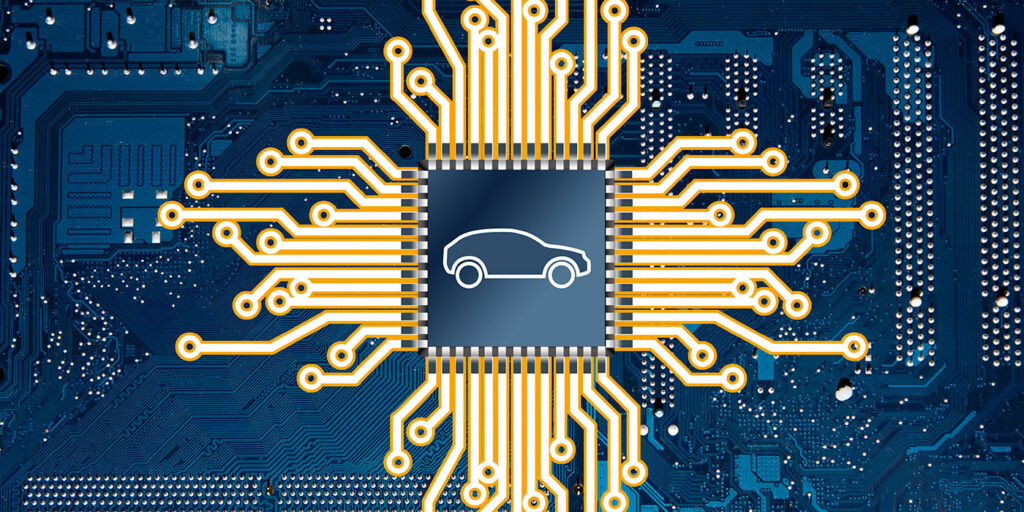The automotive industry has faced a number of supply chain and inventory challenges since early 2020. Between the COVID-19 pandemic, natural disasters, changing consumer behaviors, trade wars and cross-industry competition, there has been no shortage of strains to business as usual. However, thanks to shifting industry perspectives, new collaborative approaches and more recent inventory projections, there is now hope on the horizon for increased new inventory production and improved supply chain flow.
First Off – How Did We Get Here?
When the auto industry, particularly plants, started shutting down due to COVID-19, OEMs started lowering their forecasts and reducing orders for semiconductor chips from factories in southeast Asia. That’s also when a lot of the semiconductor chip supply was diverted to other tech and communication industries, and chip fabrication plants had less capacity to take on new orders.
Once companies were ready to ramp up production and put semiconductor chips in cars again, the facilities they previously used no longer had the capacity to accept and fill those orders – or the ability to create older chip technology that most of the automotive industry was still relying on. Ultimately, all of this – combined with labor shortages, weather disasters, political tensions between the United States and China and an increasing number of supply chain bottlenecks – is what led to the semiconductor chip shortage and its enormous impact on auto manufacturers.
To combat the ongoing semiconductor chip shortage, vehicle retailers have and are still seeking out new, innovative ways to acquire inventory wherever, and whenever, possible – oftentimes going straight to consumers to purchase their vehicle to quickly turn around and sell. However, these practices, paired with the lack of new vehicle inventory and increased consumer demand for vehicles in general, have caused used car prices to skyrocket as much as 40% between January 2020 and January 2022.
However, for the first time since these crises began, there are signs the tide is shifting for the industry, and rising numbers of new vehicle production are on the horizon.
A Resurgence in the Supply Chain
OEMs have recently been signaling expected ramp-ups in new vehicle production for both Q1 and Q2 of this year. While these OEMs acknowledge the industry will not see full production immediately due to the supply chain delays and the shortage of critical parts like chips, they believe retailers and consumers should begin seeing more available inventory in the second half of the year. With vehicle production slowly ramping up, used vehicles should also eventually begin to return to a more normalized pricing structure.
Many are also predicting a smoothing out of supply chain and semiconductor chip strains over the next year. One promising sign is that a number of OEMs and their suppliers are starting to rethink how they approach all parts of the semiconductor design, production and shipment process to help secure more supply chain resilience moving forward. Automotive players are also bringing together different tiers of suppliers to form multi-enterprise supply coordination between the automotive and semiconductor chip sectors – something that’s usually seen more often tech industry. Prime examples of this are the recent coordinated moves between Tesla, Broadcom and TSMC, as well as Conti & Bosch and Recogni.
OEMs and suppliers are also considering forming global purchasing alliances to improve the chip procurement process. Reworking and aligning on procurement practices will be critical going forward, as OEMs have historically relied more on just-in-time (JIT) inventory management while the semiconductor chip sector is known for limited short-term flexibility when it comes to changing output.
Certain manufacturers, like BMW, have fared better than other automotive companies during this chip crisis. This is in large part because it has focused more on business relationships with chip suppliers for the better part of decade – resulting in other OEMs looking at this transparent and risk mitigating business model and rethinking how to better collaborate and communicate between themselves and chip suppliers.
And because the entire process of designing, ordering, producing and delivering semiconductor chips is truly a global process, the automotive industry is certainly affected by whatever happens on the geopolitical stage. OEMs and other automotive players were pleased when the Senate passed the United States Innovation and Competition Act (USICA), which provides $50 billion for semiconductor chips to be manufactured in America. In South Korea, $450 billion has been allocated over the next several years to construct chip-building fabrication facilities (chip fabs), while Europe and Japan have also expressed desires to take over a portion of worldwide chip production. Many other countries are expected to follow this pattern across the next three years as well – a promising sign for an automotive industry that’s been pushing for ramped up production of semiconductor chips.
What Retailers Can Do Now
Even though the industry is anticipating higher new vehicle production in the months to come, for now, retailers are simply trying to navigate supply chain backlogs and inventory challenges, while also reaching a broad base of consumers. Many retailers are now targeting customers not just in their immediate area, but also regionally or nationally, with the goal of reaching those consumers who want the exact make and model they are ready to sell.
Some retailers are taking advantage of new offers from OEMs, like General Motors, that provide vouchers to customers purchasing vehicles now – and in-turn, to later return and receive luxury amenities, such as heated seats, that require semiconductor chips. With this type of offer, a customer may not receive the chip-dependent amenity right now, but they can still plan on acquiring those amenities at no extra cost once semiconductor chips are more readily available again.
Beyond all this, many retailers are now going directly to consumers for vehicle acquisition, particularly to purchase vehicles that are used but in good condition and that can be easily resold. Logistics become especially critical with such customer vehicle acquisitions. With a strategic vehicle acquisition process in place and the right logistics partner to execute the strategy, retailers can keep inventory moving, reconditioning or repairing incoming vehicles as needed and ensuring they have the types of vehicles they need to meet their customers’ demands.
Finding unique ways to source inventory like this, expanding the area in which they hunt for such inventory and making sure they have the logistics support in place to transport inventory wherever needed are all important steps retailers can take now during this transitional period – before supply chain woes are remedied and new vehicle production slowly ramps up again.
Many logistics providers offer more than just transport options including service offerings like vehicle storage, reconditioning, title and registration and more. Ideally, retailers will partner with a provider that can help expand their services, customize a logistics program to move inventory fast and increase speed to market. A well-established, smooth running logistics program can keep vehicle inventory moving in and out, ensure repairs or maintenance occurs where needed and, if a retailer requests additional servicing like detailing or title and registration, that vehicles are made fully ready-to-drive before they ever head to their destination.














